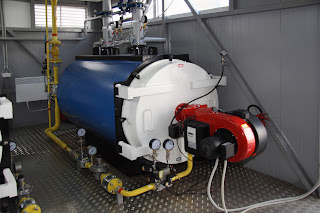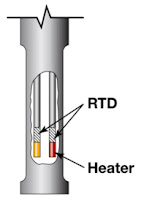 |
| Pressure relief valves protect this industrial boiler from conditions beyond maximum allowable working pressure |
Manufacturers of what most generally refer to as pressure relief valves break the genre down into two distinct groups, relief valves and safety valves. One manufacturer, Anderson Greenwood (a Pentair brand), distinguishes the two valve types in their "Pentair Pressure Relief Valve Engineering Handbook"...
Relief Valve: A pressure relief valve characterized by gradual opening or closing generally proportional to the increase or decrease in pressure. It is normally used for incompressible fluids.
Safety Valve: A pressure relief valve characterized by rapid opening or closing and normally used to relieve compressible fluids.The difference between the two valve types is found in their response to an excessive pressure condition. The relief valve, according to the definition, responds proportionally to the pressure increase, whereas the safety valve provides a non-proportional rapid response. Note also that the relief valve is generally intended for use with liquids (incompressible) and safety valves are commonly applied to compressible fluids, which would include steam and air.
 |
| Pilot Operated Pressure Relief Valve Courtesy Anderson Greenwood |
Pressure relief valves are found anywhere pressure is contained, be it a piping system, vessel, even a
Because of the potentially catastrophic nature of a pressurized system failure, there is a high level of scrutiny, regulation, and testing focused on pressure relief and safety valves. The proper sizing and selection of the valves is also critical to providing proper function.
I have included a product bulletin from Anderson Greenwood with this article. Browse through it. It provides solid technical information, along with some excellent cutaway illustrations showing how the valves function. You are bound to discover something you did not know about safety and relief valves and their proper application. You can also contact the specialists at Miller Energy for assistance in proper valve sizing and selection.





